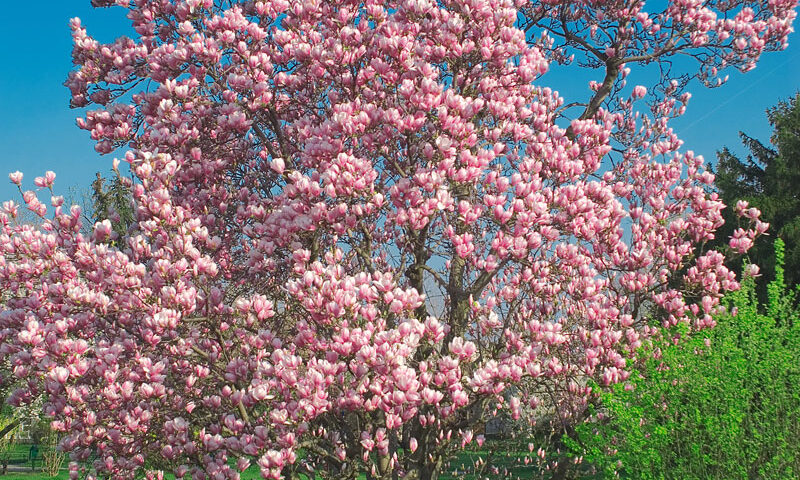Magnolia scale may not look like much at first glance. Initially, many homeowners don’t even realize they are looking at an insect!
Magnolia scale may look innocuous enough, but they can be deadly to magnolia trees. Luckily, magnolia scale can be effectively treated during your annual lawn maintenance.
Magnolia Scale Life Cycle
There are two main species of scale: armored (hard body) and non-armored (soft body).
Magnolia scale is a soft body insect, which can make the process of tree maintenance treatment slightly easier because this type of scale is more vulnerable.
However, it is important to properly identify the pest as early as possible for treatment to have maximum effect. To help, here is a brief overview of the magnolia scale life cycle.
Winter: scale goes dormant.
During the winter season, magnolia scale goes dormant. The insects typically spend the winter in nymph form encased in soft protective wax on the undersides of tree leaves and branches.
Spring: mating and incubation.
In the spring, the adults emerge and mate. The male dies off and the female begins to incubate the young as eggs she lays right underneath her own body.
Summer and fall: birth and feeding.
The adult female covers the eggs with her body until the live young emerge. The young at this stage are called “crawlers.” But the young crawlers only crawl around for as long as it takes to locate a suitable place to sink their sharp mouth parts into the tree branches and start sucking the sap right out of them.
By this time, the cold season is rolling in again, and the now-stationary crawlers enter the nymph stage for the winter right where they sit. Then in the spring the whole life cycle will start all over again.
How to Spot Magnolia Scale
The first thing to know about magnolia scale is that it doesn’t behave like a typical insect. It only moves during spring when adults mate and crawlers are born. Then it stays immobile for the remainder of its life cycle.
For this reason, many homeowners who schedule tree maintenance initially report that their magnolia trees appear to be growing “mold” or have an “ant infestation.”
Magnolia scale often does look a lot like mold or mildew once it settles in to feed on tree branches. It is bumpy and white with a waxy, semi-soft appearance that looks like nothing so much as the early stages of mold rot.
But inside and underneath this “mold,” the now-immobile feeding crawlers are busy feeding on the amino acids in the tree sap. Along with the amino acids they need, the crawlers take in plenty of sugars they don’t need. So they discard the carbohydrate-laden sugar in the form of a sticky substance called “honeydew.” This honeydew in turn attracts ants, wasps, flies, bees and molds that recognize a feast when they see it.
For this reason, sometimes the first indication of a magnolia scale infestation is the honeydew itself. This is especially the case if the infested tree overhands a deck, set of patio furniture, vehicle or walkway. Honeydew is incredibly sticky and corrosive. It will turn anything it lands on sticky. It stains and is very hard to remove.
The presence of honeydew is confirmation of a magnolia scale infestation nearby.
When to Treat Infested Trees for Magnolia Scale
While healthy magnolia trees can generally withstand small, localized attacks of magnolia scale, these pests generally do not go away on their own. Over time, undetected and untreated magnolia scale can kill a tree by draining away its nutrient supply.
Luckily, there are a number of insecticide products that are effective against magnolia scale if they are applied correctly at the right time.
Here, learning about the magnolia scale life cycle is key to successfully terminating an infestation.
The crawler stage (whether mobile or immobile) is the time in the life cycle when magnolia scale are most vulnerable. The adult females give birth in late summer – anywhere from July to September depending on where you live. So this is generally the best time to apply insecticide to treat magnolia scale.
How to Treat Infested Trees for Magnolia Scale
The optimal treatment approach will maximize damage to magnolia scale while limiting damage of surrounding foliage and beneficial insect life.
Here, it is vital to select a lawn maintenance professional to apply treatment to avoid harming nearby lawns, shrubs and unaffected trees.
The first step is to identify the scope of the infestation and the part of the life cycle the scale is currently in.
Summer and fall treatment.
For a small-scale active infestation, it may be possible to simply prune back the affected tree branches and treat just the immediate surrounding branches to ensure it does not spread.
For large-scale infestation limited to one tree or affecting multiple trees, spray insecticides containing horticultural oils and insecticidal soaps can effectively treat magnolia scale in the crawler stage.
Winter and early spring treatment.
Once magnolia scale has entered the dormant stage, treatment requires a different approach.
There is a dormant oil product that can be applied directly to the dormant scale that must be applied before the bud open up in spring, which can happen as early as March in some areas.
Systemic insecticide products can be used to treat the soil surrounding the tree itself. When applied during the winter dormant period, these insecticides will have time to be absorbed into the tree and taken into the sap so it will kill the crawlers when they emerge in the spring.
By understanding what a magnolia scale infestation looks like at different times of the year, it is possible to make a positive identification earlier in the life cycle when the scale are at their most vulnerable.
By identifying magnolia scale accurately and early, a number of effective tree maintenance treatments exist to eliminate infestation and restore tree health.


